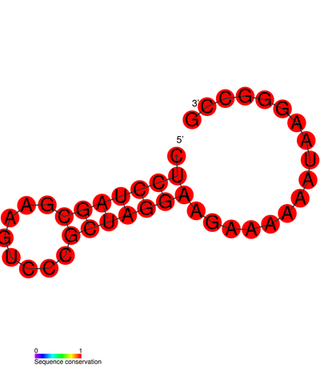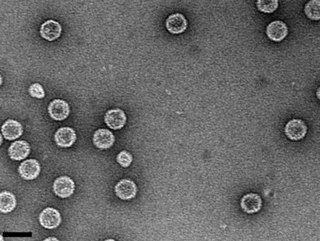Virus classification is the process of naming viruses and placing them into a taxonomic system similar to the classification systems used for cellular organisms.
Echovirus is a polyphyletic group of viruses associated with enteric disease in humans. The name is derived from "enteric cytopathic human orphan virus". These viruses were originally not associated with disease, but many have since been identified as disease-causing agents. The term "echovirus" was used in the scientific names of numerous species, but all echoviruses are now recognized as strains of various species, most of which are in the family Picornaviridae.
Mardivirus is a genus of viruses in the order Herpesvirales, in the family Herpesviridae, in the subfamily Alphaherpesvirinae. Chickens, turkeys, and quail serve as natural hosts. There are six species in this genus. Diseases associated with this genus include: Marek's disease, which causes asymmetric paralysis of one or more limbs, neurological symptoms, and development of multiple lymphomas that manifest as solid tumors. Gallid herpesvirus 2 is the only one of these viruses known to be pathogenic and due to the antigenic similarity between the three viruses the other two have been used to vaccinate against Marek's disease. These viruses have double stranded DNA genomes with no RNA intermediate.
Tenuivirus is a plant virus genus belonging to Phenuiviridae family in the order Bunyavirales. These plant viruses cause diseases in their host plants. Typical symptoms are chlorotic stripes on the affected leaves. This group of viruses make viral inclusions in infected cells which can be used to diagnose infection.

Closterovirus, also known as beet yellows viral group, is a genus of viruses, in the family Closteroviridae. Plants serve as natural hosts. There are 17 species in this genus. Diseases associated with this genus include: yellowing and necrosis, particularly affecting the phloem. This genus has a probably worldwide distribution and includes among other viral species the Beet yellows virus and Citrus tristeza virus, rather economically important plant diseases. At least some species require vectors such as aphids or mealybugs for their transmission from plant to plant.

Trichovirus is a genus of viruses in the order Tymovirales, in the family Betaflexiviridae. Plants, specifically angiosperms such as pome fruits, citrus, and pear, serve as natural hosts for this plant pathogen. There are seven species in this genus.

Picobirnavirus is a genus of double-stranded RNA viruses. It is the only genus in the family Picobirnaviridae. Although amniotes, especially mammals, were thought to serve as hosts, it has been recently suggested that these viruses might infect bacteria and possibly some other invertebrates. There are three species in this genus. Associated symptoms include gastroenteritis in animals and humans, though the disease association is unclear.
The hop stunt viroid is a viroid species that infects the common hop plant, citrus plants and grapevines, among others. It is a member of the Pospiviroidae family and the Hostuviroid genus. There are quite a few different sub-species of the hop stunt viroid.
Cilevirus is a genus of viruses in the family Kitaviridae. Plants serve as natural hosts. There are two species: Citrus leprosis virus C and Citrus leprosis virus C2.
Vitivirus is a genus of viruses in the order Tymovirales, in the family Betaflexiviridae. Plants serve as natural hosts. There are 15 species in this genus.
Grapevine virus A (GVA) is a moderately common genetic virus that affects Vitis vinifera and American Vitis grapevine species throughout the world and can be fatal if not treated. Grapevine virus A is in the family Betaflexiviridae and genus Vitivirus. The common name for this virus is grapevine closterovirus. Common symptoms in infected grapevines include stem pitting. Although there is a treatment available to cure infected grapevines, it is not one hundred percent effective, so preventative measures are the best solution to the virus. Every inhabited continent on the globe has had breakouts of grapevine closterovirus due to the complex genetic makeup of the virus. Grapevine virus A has a single-stranded RNA genome, which is similar to that of Grapevine virus B. There are multiple strains of the virus that vary both molecularly and biologically which account for the slightly different symptoms exhibited by infected plants.
Grapevine virus B is plant virus species in the genus Vitivirus. It is associated with rugose wood symptoms in grapevine.
Fabavirus is a genus of plant viruses in the order Picornavirales, in the family Secoviridae, in the subfamily Comovirinae. Plants serve as natural hosts. There are seven species in this genus.
Ampelovirus is a genus of viruses, in the family Closteroviridae. Plants serve as natural hosts. There are 13 species in this genus. Diseases associated with this genus include: yellowing and necrosis, particularly affecting the phloem.
Enamovirus is a genus of viruses, in the family Solemoviridae. Plants serve as natural hosts. There are five species in this genus. Diseases associated with this genus include: pea enation disease: if both PEMV-1 and PEMV-2 are present.
Foveavirus is a genus of viruses in the order Tymovirales, in the family Betaflexiviridae. Plants serve as natural hosts. There are eight species in this genus. Diseases associated with this genus include: mosaic and ringspot symptoms.
Velarivirus is a genus of viruses, in the family Closteroviridae. Plants serve as natural hosts. There are eight species in this genus. Diseases associated with this genus include: GLRaV-7: symptomless in white-berried grapevine cultivar from Albania. However, it induces leafroll symptoms onto grafted cv. cabernet.

Phenuiviridae is a family of negative-strand RNA viruses in the order Bunyavirales. Ruminants, camels, humans, and mosquitoes serve as natural hosts. Member genus Phlebovirus is the only genus of the family that has viruses that cause disease in humans except Dabie bandavirus.
Grapevine red blotch disease (GRBD), also known simply as red blotch, is a viral disease of grapevine. The disease is caused by a single-stranded circular DNA virus, the species grapevine red blotch virus, also known as grapevine red blotch-associated virus, GRBaV. First identified in California, the disease affects grapevines of all varieties and is internationally present. Symptoms typically include red blotches on the leaves of red varieties and in pale green or pale yellow blotches on white varieties. It significantly reduces the value of juice collected from the berries of affected vines, costing vineyard owners as much as $65,000 per acre.
Apple rubbery wood virus, also known as apple rubodvirus is a viral disease that causes apple rubbery wood in apple and pear cultivars. There are two varieties: ARWV 1 and ARWV 2. It gets its name from its distinctive effect that it has on its host trees, which show unusual flexibility in the stems and branches after a few years of infection. This often results in the maturing fruits of the tree to weigh down the branches such that they lay on the ground. Apple rubbery wood, or ARW, occurs worldwide, affecting apple and pear cultivars in most developed countries.



